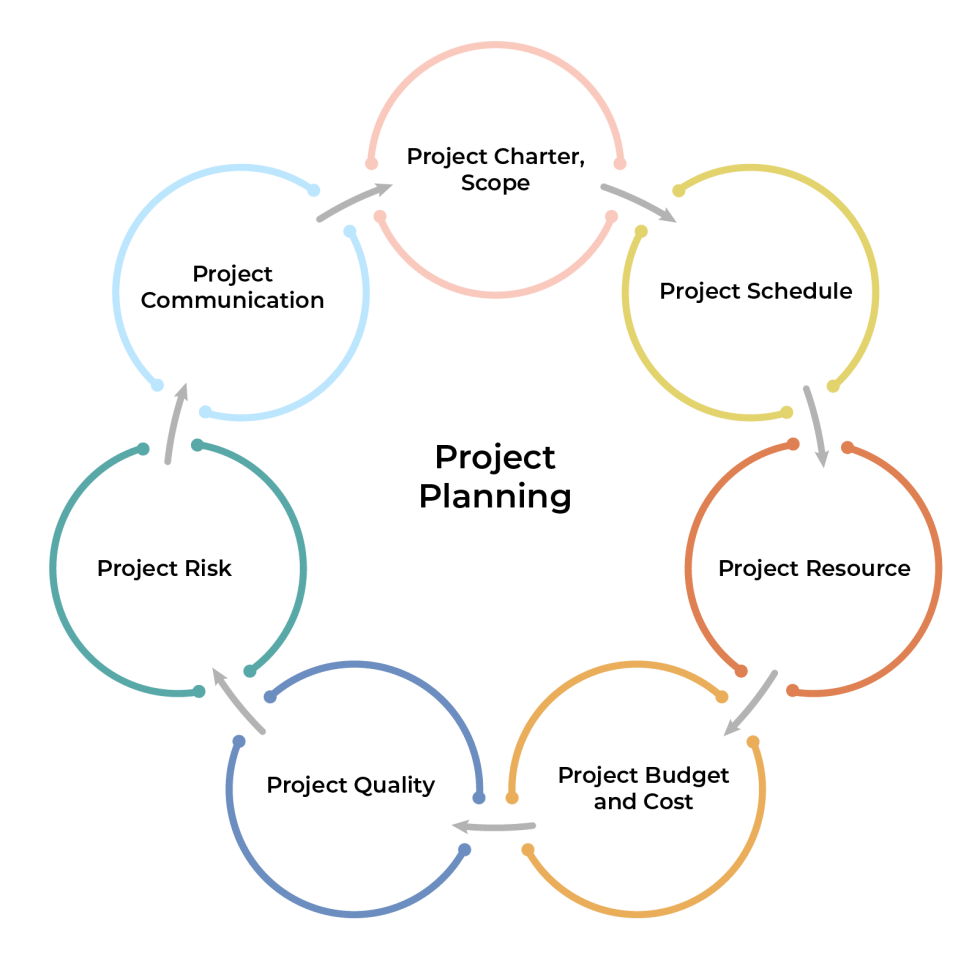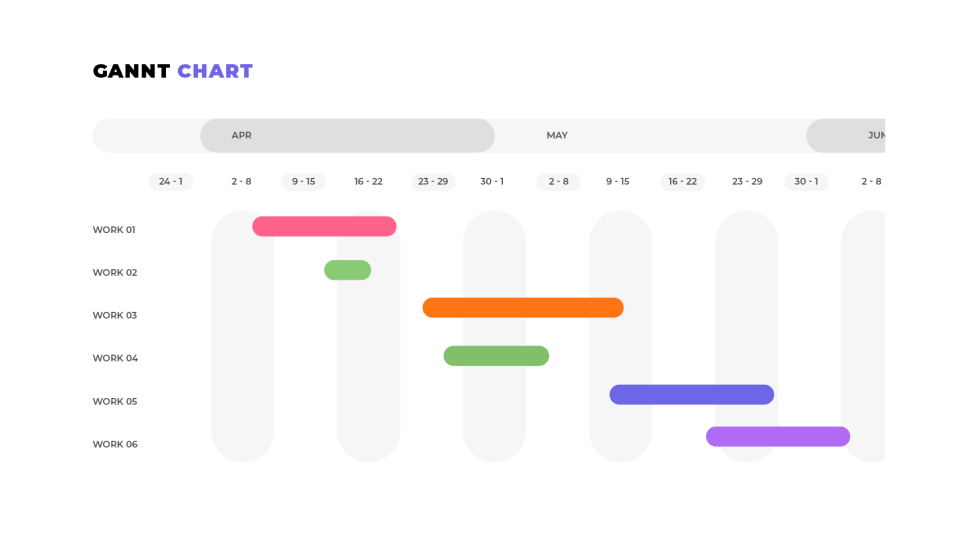Project Management Guide
Project Management Guide
What Is Project Management?
What Is a Project?
Why Is Project Management Important?
Project Life Cycle Phases
- Project Initiation
- Project Planning
- Project Execution
- Project Monitoring
- Project Closure
Project Management Methodologies
- Waterfall Project Management
- Critical Path Method
- Critical Chain Project Management
- Agile Project Management
- Scrum Project Management
- Kanban Project Management
- Lean Project Management
- Six Sigma Project Management
- PRINCE2
- PRiSM
- PMBOK Method
Project Management FAQ
What is Planning in Project Management
Let’s start at the very beginning. What exactly is project management planning, and why do you need to do it?
Simply put, you need to plan a project in order to provide an overview of the project goals, define how targets will be met, who will be involved in the work, and how it will be measured.
In short, planning is an efficient way for you to get from the very start of a project to the very end. A project management plan is a structured document that defines the nature of the project and its execution.
According to the Project Management Institute, project planning is one of the five phases of project management. They recommend starting with goals that are SMART: Specific, Measurable, Realistic, and Timely.
Now, let’s examine all aspects of project management planning. These are:
- Steps in Project Management Planning
- How to Create A Project Management Plan
- Some Project Management Plan Formats
- Best Practices in Project Management Planning
It’s important to note that a project management plan is not something that’s simply created at the start of a project and then put aside. Planning is a dynamic process as well as a touchstone and guide to be referred to during the course of a project.
As such, it’s a document that evolves. With updates, information, and course corrections that are added as the project progresses.

Steps in Project Management Planning
In the book Project Management by Adrienne Watt, the purpose of planning in project management is specifically laid out. This is to:
- Establish business requirements
- Establish cost, schedule, list of deliverables, and delivery dates
- Establish resources plans
- Obtain management approval and proceed to the next phase
Therefore, at the start, some thought has to be given to the above aspects. The project manager needs to discuss this with stakeholders and the team and get a clear buy-in and approvals.
Then, all of these need to be broken down into actionable components. Typically, these are:
- The Scope: Here, the project manager should get clarity on the overall scope of the project and the deliverables involved.
- The Tasks: Once the big picture of the project is clear, it should be broken down into tasks and subtasks.
- The Scheduling: With the tasks in mind, a schedule should be created of various activities, their interdependence, and their deadlines.
- The Resources: This is a key aspect. A summary of resources available should be created, with indicators of which ones will be applied to which tasks.
- The Budget: Here, the project manager provides a snapshot of the overall costs and the main heads in which they will be incurred
- The Procurement: For complex tasks, thought needs to be given to the outside vendors and subcontracting.
- The Risks: Almost no project proceeds as smoothly as planned. Therefore, the project manager should try and anticipate risks and changes, as well as strategies to overcome them.
- The Quality: In this section, standards for approval should be specified. Is there a minimum threshold below which work will not be accepted?
- The Targets: When can a project be considered to be finished? What is the approval process?
As a project manager, you know that every project is different. However, keeping the above aspects in mind will enable you to come up with a robust and actionable plan that will power the project to completion.
How to Create a Project Management Plan
As the University of Virginia’s program on project management puts it, “project management provides organizations (and individuals) with the language and the frameworks for scoping projects, sequencing activities, utilizing resources, and minimizing risks.”
In order for a plan to take off and land successfully, a project management plan is essential. This is the framework that they refer to in the definition above.
The components of a project management plan that were laid out above have to be distilled into a plan that will serve as a roadmap for the project.
In order to write an effective project management plan, you should incorporate the components in an actionable manner.
The need is to:
- Determine the business requirements
- Ascertain costs, schedules, deliverables, and deadlines
- Allocate resources
- Sketch out alternative plans
An important part of the above is how to measure various aspects of the project. For this, the project plan should include:
- The method of monitoring the progress of a project
- The people authorized to overview and approve specific parts of the project
- The criteria used in the evaluation
- The processes to be relied on while proceeding with the project
- The implementation schedules
While preparing a project plan and also while implementing it, communication is critical. In fact, for specific projects, it would make sense to spell out a detailed communication plan.
This can set out guidelines for what sort of information will be shared, and how. It can also specify who needs to be looped in on each project communication.
To sum up, a good project plan should incorporate goals, deliverables, accountability, use of resources, and deadlines. Clearly, project managers also need to keep stakeholders in the loop from the start and incorporate their feedback into the plan.
Some Project Management Planning Formats
It may seem like a daunting task to keep track of all the components of a project management plan and then put them down in a progressive manner.
Fortunately, there are several tools, templates, and formats available that are a great help to project managers. Some of these are in the form of established practices, and some in the form of software.
Among the most popular is a Gantt chart. This is a bar chart that shows a view of tasks scheduled. It is used for planning all types of projects.
Caption: An example of a Gantt chart.

With a Gantt chart, you can easily see the start and end dates, project tasks, how the tasks are linked, and who is working on them.
There are also various types of software available that can be invaluable in the project planning process. Which one to use will depend on project size and complexity, whether it’s a small or large team, the resources involved, and so on.
In general, such software helps in planning because of collaborative features, time tracking, breaking down the dependencies of tasks, and providing an overview of the status of the project at any given time.
This means the what, why, how, and when of a given project is easily accessible by the project manager and all others involved. Such templates should also enable easy overviews of the workflow, task breakdown, and dependencies, reviews, and collaboration.
Some Project Planning Best Practices
Now that you have a comprehensive overview of what project planning is and how to go about creating a project plan, let’s look at some best practices.
All of these have been tried and tested over the years by experienced project managers. They can make the difference between an adequate project plan and a perfect one.
- Collaboration: No project is the result of one person’s efforts. It makes sense, then, to collaborate at every step. Ideally, a draft project can be presented to team members and stakeholders. Based on their inputs, a final plan can be drawn up.
- Professionalism: Especially when dealing with clients and senior stakeholders, an element of professionalism is crucial. The business case should be properly made as well as assessments of quality and scope.
- Risk anticipation: As pointed out, no project is also without risks. It makes sense to anticipate them, prepare for them, and create fall-back options in order to deal with them. This also minimizes the time spent in handling unexpected occurrences if and when they arise.
- Change management: Often, the circumstances of a project change along with its progress. There could be a social shift, or a rise in input costs, or even scope creep. A professional project manager will incorporate all of these into the planning process.
- Team selection: While planning, it’s important to create a proper allocation of tasks. The right people, with the right experience, should be chosen. Resources should also be discussed and apportioned.
- The Right Tools: From material to software, you should ensure that the team you have picked has the right tools to successfully accomplish the tasks that have been set for them. Without this, no project will be able to proceed flawlessly.
Project planning is an essential stage of any project. It’s worth spending time over it and discussing it with key personnel. A good project plan will provide clarity, information, and be an invaluable guide throughout the life-cycle of a project.
